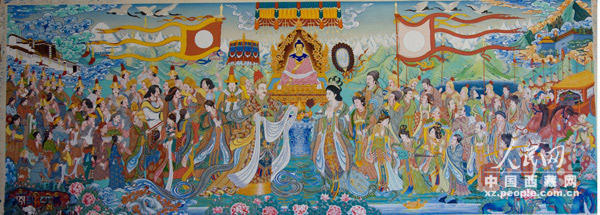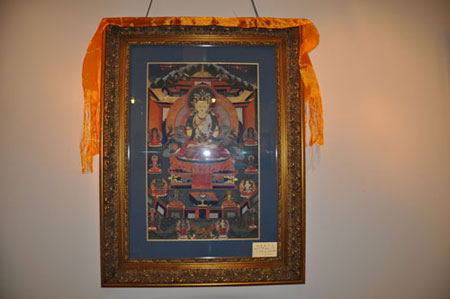
Photo shows a thangka titled "Princess Wencheng enters Tibet" designed by renowned thangka artist Nyangbon and jointly painted by artists Heren Qingjia and Sang Gyibo. (Photo/ xz.people.com.cn)

Photo taken on June 15, 2009, shows a piece of Thangka of Amitayus in an art gallery in the Aijia International Collection Market in Beijing. (Photo/Xinhuanet)
Pei Xiaojun, famous collector and chairman of the Gansu Collectors' Society, is a big fan of Tibetan Thangka (traditional Buddhist painting or embroidery work usually hung in ceremonial services by Tibetan people). Within ten years, he has collected more than 1,500 pieces of Thangka, ranging from those worth several thousand yuan RMB to millions worth of treasures.
He wrote a book on Thangka collecting - My Thangka Collection.
Pei has rich life experiences. He learned painting in his childhood, went to work and live in the countryside during the Cultural Revolutions (1966-1976). After he went back to work in the city, he engaged in economic crime investigation, and became a businessman after that.
In 1988, Pei saw three small Thangka in a friend's home. They were so dazzlingly beautiful that they instantly fascinated Pei.
"I was so excited, and could tell that my life was bound with this ancient art of painting. After that encounter, I was deeply interested in Thangka, and began my journey of Thangka research and collection," he recalled the moment from which his life became inseparable with Thangka.
Pei often stayed up reading books and conducting research on Thangka. To learn about the making process of this ancient art and distinguishing the authentic ones from the counterfeits, he even studied the history of Chinese textiles and painting materials. Those studies enable him to tell when a piece of Thangka was made, which makes him a nationwide famous expert on Thangka.
"I've seen so many Thangka that I can tell when a piece of Thangka was painted using only my nose," he said with much confidence.
His book includes 1,403 Thangka pictures with illustrations of 86,000 words, explaining in detail the origin, types, making, contents, and spread of Thangka.
Pei said, "Here I share my years of experience of collecting Thangka with the public, and hope this book can be helpful to Thangka fans and collectors."
